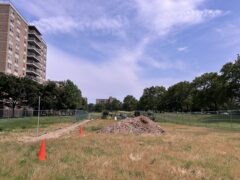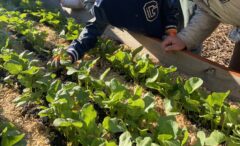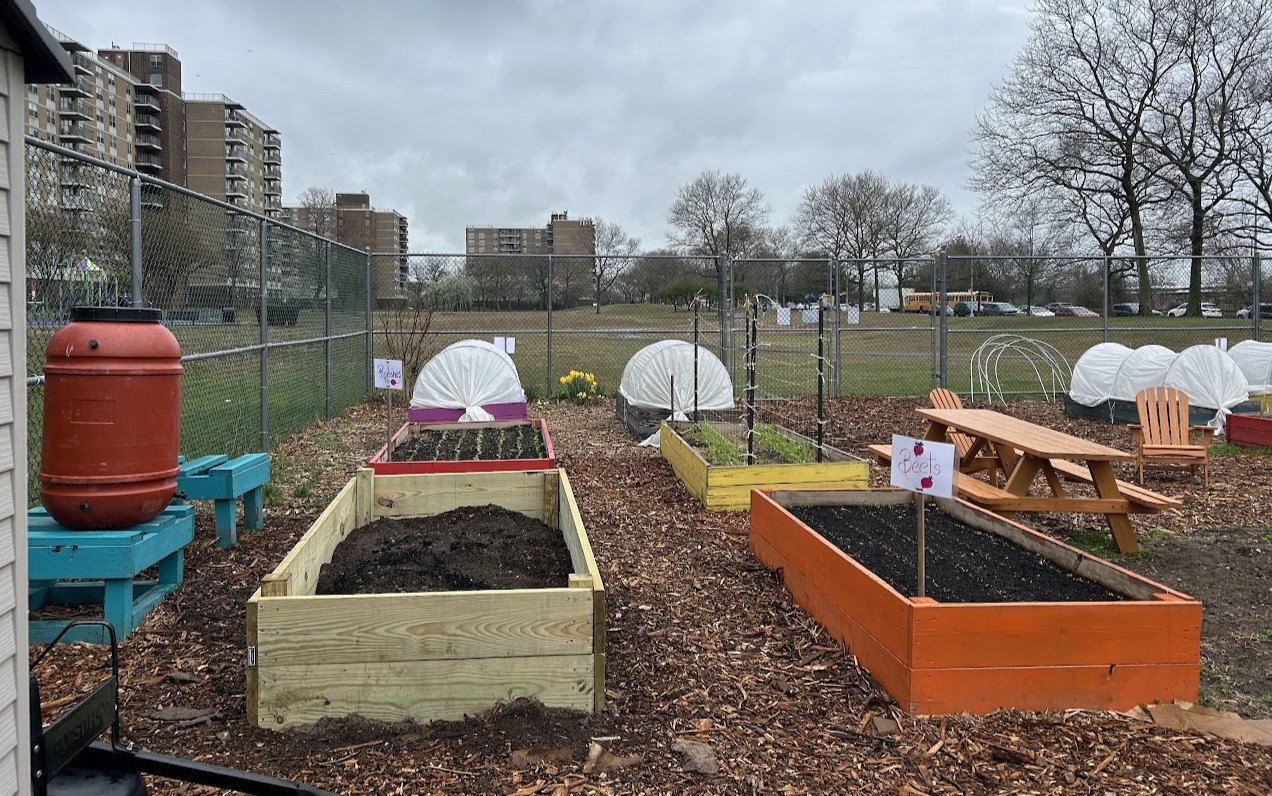Like their rural counterparts, urban farmers are facing more drought, heat, heavy rain, floods, and high wind events. Adapting to these challenges is not one-size-fits-all. Many farmers have been struggling to remain productive and profitable. In New York City (NYC), farmers experience unique micro-climates across the five boroughs; each created by its geographic location and surrounding infrastructure. Some farms experience strong winds caused by daily temperature swings. Others deal with frequent flooding and saltwater intrusion caused by rising sea levels.
In response to these challenges, the USDA Northeast Climate Hub and Cornell University’s Cooperative Extension delivered the Urban Climate Adaptation and Mitigation Program (Urban CAMP). Since January 2025, participating NYC farmers and agricultural advisors have been exchanging evidence-based information and adaptation strategies to increase their on-farm resilience.
One Fellow, Jesse Miller, recently shared his thoughts and experiences surrounding adaptation strategies for resilience. As the farm manager at Spring Creek Towers Farm in Brooklyn, NY Jesse first attended Urban CAMP to connect with other farmers about adaptation.

The farm was established in 2011 (And reopened in 2023) within a tall affordable-housing complex (Starrett City) in a large open field that borders Jamaica Bay. These factors create strong wind conditions in the vegetable plot. Jesse Miller, The Opportunity Hub
“Now I know all these other people from CAMP that I can keep connecting with, and I learned about programs that I didn’t know existed… We really need to be combining our knowledge as producers, in order to stay productive in the city.”
While Jesse has farmed in rural areas before, he says farming in the city is a whole different ballgame. “Here in the urban environment, you are constantly thinking about climate because it’s so extreme here,” he explained. In response to these extremes, Urban CAMP’s lecture series covered both the climate impacts on farms in NYC and adaptation strategies urban producers can use.

Jesse hosts weekly gardening classes with PS 346. Students attend an 8-week Fall gardening program and a 12-week Spring gardening program focusing on urban agriculture and ecosystem science. Jesse Miller, The Opportunity Hub
The Spring Creek Towers Farm property is located on a peninsula bordered by wetlands, freeways, and a former landfill turned state park. This location has come with a few unique challenges for their farm.
Wind: “There’s the heat, and then there’s the wind…” remarks Jesse. While high winds are typical for Brooklyn neighborhoods, persistent winds whip through the site at Spring Creek Towers causing damage to both crops and infrastructure. Jesse set up a trellis system to mitigate the effects of high winds but learned the hard way that what you trellis with can make all the difference.
“We [now] use rebar posts and the thickest plastic that U-Line sells. Last year we used Jute twine and didn’t get the thickest rebar posts you can find. And everything just snapped. It’s crazy because this isn’t Illinois.”
When Spring Creek Towers’ trellis system broke last year, it injured crops and impacted yields. Jesse’s using stronger materials this year, but he’s trying some new strategies too. To start, almost every plant in the garden will be trellised, including crops that are not typically trellised. Additionally, in order to reduce wind speed the farm is working with USDA’s Natural Resource Conservation Service (NRCS) to install a shelterbelt, a line of shrubs planted along the border of the garden. This shrub-wall will slow down the wind at the corners of the farm where the wind is strongest, minimizing crop damage.
Heat and Pests: Significant temperature changes in NYC have stunted crops at Spring Creek Towers Farm too. Low tunnels made with agri-bond fabric and metal conduit have allowed Jesse to keep some crops alive though the shoulder seasons. This adaptation strategy has slowed crops from getting too hot and wilting or too cold and experiencing frost damage. But the problem has not been easy to solve. Heat waves and cold snaps remain troublesome.
“Temperatures get really high in the spring during the day in the city. I can’t always open up the low tunnels every day [for the heat to dissipate] … I’ve switched to keeping all the conduits in the beds and putting shade cloth on them to reduce the heat in the summer. I’m using shade cloth on the cilantro and parsley, but even with the shade cloth the parsley went to seed. It’s been really frustrating.”
In addition to making plants wilt, heat events in NYC are also impacting pest populations. The urban heat island effect makes urban growing environments more favorable to tropical and heat loving pests.
“Pepper maggots are really coming into the city. They burrow into the seeds and then emerge from them, turning the entire pepper black inside […] [During Urban CAMF] we talked about what flowers to plant and how to keep a continuous bloom throughout the year […] so that we can have positive insects in the garden.”
Promoting beneficial insects allows producers to reduce pest pressure without relying on sprays or trap crops which take up space in the vegetable plot. Typically, farmers can use crop rotation to prevent the return of a previous pest. But in the city, that’s much more challenging. “It’s kind of impossible to do crop rotation in the city when you have everybody on their apartments balconies growing whatever they want,” Jesse explained. Instead of being able to pause production of a certain crop to allow pest populations to die out, farmers have come to expect that once a pest appears there is a likelihood that it stays for more than one season. This circumstance has made learning about various pest management options even more valuable for Jesse.
As Urban CAMP progresses through 2025, the program will enable and support NYC’s agricultural adaptation journey as growers deal with micro-climates, heat waves, new pest challenges, and limited arable space surrounded by less permeable surfaces. Working alongside other urban agriculture practitioners, members of the Urban CAMP cohort will continue to identify climate impacts and implement adaptation strategies to increase their resilience. Participants – like Jesse – play an instrumental role in building the city’s agricultural resilience. These farmers experiment with new practices, identify solutions for their farms, and share their knowledge and skills with other members of the urban farming community. As the program continues, the hope is that Urban CAMP participants will create more resilient food systems both on their own farms and on the farms of their colleagues.

